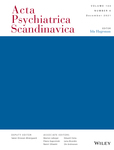Speech based natural language profile before, during and after the onset of psychosis: A cluster analysis
IF 5.3
2区 医学
Q1 PSYCHIATRY
引用次数: 0
Abstract
Background and HypothesisSpeech markers are digitally acquired, computationally derived, quantifiable set of measures that reflect the state of neurocognitive processes relevant for social functioning. “Oddities” in language and communication have historically been seen as a core feature of schizophrenia. The application of natural language processing (NLP) to speech samples can elucidate even the most subtle deviations in language. We aim to determine if NLP based profiles that are distinctive of schizophrenia can be observed across the various clinical phases of psychosis.DesignOur sample consisted of 147 participants and included 39 healthy controls (HC), 72 with first‐episode psychosis (FEP), 18 in a clinical high‐risk state (CHR), 18 with schizophrenia (SZ). A structured task elicited 3 minutes of speech, which was then transformed into quantitative measures on 12 linguistic variables (lexical, syntactic, and semantic). Cluster analysis that leveraged healthy variations was then applied to determine language‐based subgroups.ResultsWe observed a three‐cluster solution. The largest cluster included most HC and the majority of patients, indicating a ‘typical linguistic profile (TLP)’. One of the atypical clusters had notably high semantic similarity in word choices with less perceptual words, lower cohesion and analytical structure; this cluster was almost entirely composed of patients in early stages of psychosis (EPP – early phase profile). The second atypical cluster had more patients with established schizophrenia (SPP – stable phase profile), with more perceptual but less cognitive/emotional word classes, simpler syntactic structure, and a lack of sufficient reference to prior information (reduced givenness).ConclusionThe patterns of speech deviations in early and established stages of schizophrenia are distinguishable from each other and detectable when lexical, semantic and syntactic aspects are assessed in the pursuit of ‘formal thought disorder’.精神病发病前、发病期间和发病后基于语音的自然语言档案:聚类分析
背景与假设语言标记是通过数字获取、计算得出、可量化的一组测量指标,可反映与社会功能相关的神经认知过程的状态。语言和交流中的 "怪癖 "历来被视为精神分裂症的核心特征。将自然语言处理(NLP)应用于语音样本,甚至可以阐明语言中最微妙的偏差。我们的样本由 147 名参与者组成,其中包括 39 名健康对照组 (HC)、72 名首发精神病患者 (FEP)、18 名临床高危状态患者 (CHR)、18 名精神分裂症患者 (SZ)。通过一项结构化任务获得 3 分钟的语音,然后将其转化为 12 个语言变量(词法、句法和语义)的定量测量结果。然后,利用健康变异进行聚类分析,以确定基于语言的亚群。最大的聚类包括了大多数人机工程学家和大多数患者,表明了 "典型语言特征(TLP)"。其中一个非典型群组的选词语义相似性明显较高,但感知词较少,内聚力和分析结构较低;该群组几乎全部由早期精神病患者组成(EPP - 早期特征)。结论精神分裂症早期和稳定期的言语偏差模式是可以相互区分的,而且在评估 "形式思维紊乱 "时,可以从词汇、语义和句法方面发现这些模式。
本文章由计算机程序翻译,如有差异,请以英文原文为准。
求助全文
约1分钟内获得全文
求助全文
来源期刊

Acta Psychiatrica Scandinavica
医学-精神病学
CiteScore
11.20
自引率
3.00%
发文量
135
审稿时长
6-12 weeks
期刊介绍:
Acta Psychiatrica Scandinavica acts as an international forum for the dissemination of information advancing the science and practice of psychiatry. In particular we focus on communicating frontline research to clinical psychiatrists and psychiatric researchers.
Acta Psychiatrica Scandinavica has traditionally been and remains a journal focusing predominantly on clinical psychiatry, but translational psychiatry is a topic of growing importance to our readers. Therefore, the journal welcomes submission of manuscripts based on both clinical- and more translational (e.g. preclinical and epidemiological) research. When preparing manuscripts based on translational studies for submission to Acta Psychiatrica Scandinavica, the authors should place emphasis on the clinical significance of the research question and the findings. Manuscripts based solely on preclinical research (e.g. animal models) are normally not considered for publication in the Journal.
 求助内容:
求助内容: 应助结果提醒方式:
应助结果提醒方式:


